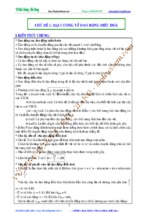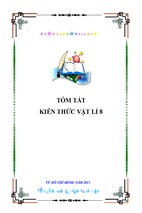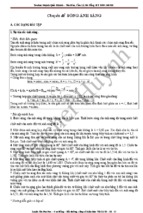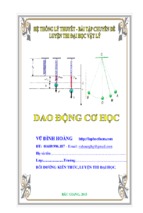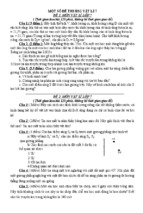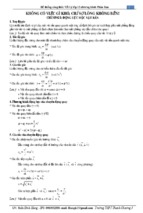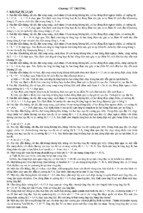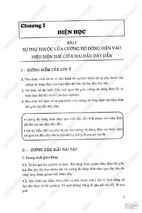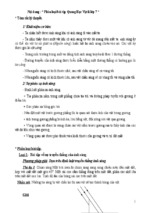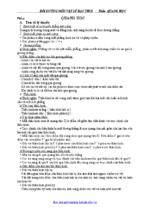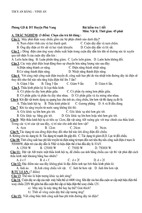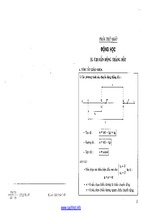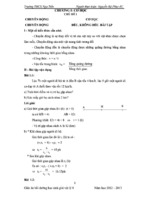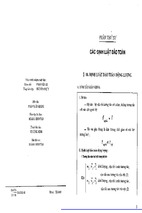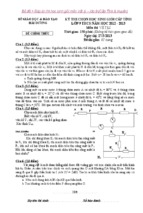This page intentionally left blank
STATISTICAL THERMODYNAMICS: FUNDAMENTALS
AND APPLICATIONS
Statistical Thermodynamics: Fundamentals and Applications discusses the
fundamentals and applications of statistical thermodynamics for beginning
graduate students in the engineering sciences. Building on the prototypical
Maxwell–Boltzmann method and maintaining a step-by-step development of
the subject, this book makes few presumptions concerning students’ previous
exposure to statistics, quantum mechanics, or spectroscopy. The book begins
with the essentials of statistical thermodynamics, pauses to recover needed
knowledge from quantum mechanics and spectroscopy, and then moves on to
applications involving ideal gases, the solid state, and radiation. A full introduction to kinetic theory is provided, including its applications to transport
phenomena and chemical kinetics. A highlight of the textbook is its discussion
of modern applications, such as laser-based diagnostics. The book concludes
with a thorough presentation of the ensemble method, featuring its use for real
gases. Each chapter is carefully written to address student difficulties in learning this challenging subject, which is fundamental to combustion, propulsion,
transport phenomena, spectroscopic measurements, and nanotechnology. Students are made comfortable with their new knowledge by the inclusion of both
example and prompted homework problems.
Normand M. Laurendeau is the Ralph and Bettye Bailey Professor of Combustion at Purdue University. He teaches at both the undergraduate and graduate
levels in the areas of thermodynamics, combustion, and engineering ethics. He
conducts research in the combustion sciences, with particular emphasis on laser
diagnostics, pollutant formation, and flame structure. Dr. Laurendeau is well
known for his pioneering research on the development and application of both
nanosecond and picosecond laser-induced fluorescence strategies to quantitative species concentration measurements in laminar and turbulent flames. He
has authored or coauthored over 150 publications in the archival scientific and
engineering literature. Professor Laurendeau is a Fellow of the American Society of Mechanical Engineers and a member of the Editorial Advisory Board
for the peer-reviewed journal Combustion Science and Technology.
Statistical Thermodynamics
Fundamentals and Applications
NORMAND M. LAURENDEAU
Purdue University
camʙʀɪdɢe uɴɪveʀsɪtʏ pʀess
Cambridge, New York, Melbourne, Madrid, Cape Town, Singapore, São Paulo
Cambridge University Press
The Edinburgh Building, Cambridge cʙ2 2ʀu, UK
Published in the United States of America by Cambridge University Press, New York
www.cambridge.org
Information on this title: www.cambridge.org/9780521846356
© Cambridge University Press 2005
This publication is in copyright. Subject to statutory exception and to the provision of
relevant collective licensing agreements, no reproduction of any part may take place
without the written permission of Cambridge University Press.
First published in print format 2005
ɪsʙɴ-13
ɪsʙɴ-10
978-0-511-14062-4 eBook (NetLibrary)
0-511-14062-2 eBook (NetLibrary)
ɪsʙɴ-13
ɪsʙɴ-10
978-0-521-84635-6 hardback
0-521-84635-8 hardback
Cambridge University Press has no responsibility for the persistence or accuracy of uʀʟs
for external or third-party internet websites referred to in this publication, and does not
guarantee that any content on such websites is, or will remain, accurate or appropriate.
I dedicate this book to my parents,
Maurice and Lydia Roy Laurendeau.
Their gift of bountiful love and support . . .
Continues to fill me with the joy of discovery.
Contents
Preface
page xv
1 Introduction
1.1 The Statistical Foundation of Classical Thermodynamics
1.2 A Classification Scheme for Statistical Thermodynamics
1.3 Why Statistical Thermodynamics?
1
1
3
3
PART ONE. FUNDAMENTALS OF STATISTICAL
THERMODYNAMICS
2 Probability and Statistics
2.1
2.2
2.3
2.4
2.5
2.6
2.7
Probability: Definitions and Basic Concepts
Permutations and Combinations
Probability Distributions: Discrete and Continuous
The Binomial Distribution
The Poisson Distribution
The Gaussian Distribution
Combinatorial Analysis for Statistical Thermodynamics
2.7.1 Distinguishable Objects
2.7.2 Indistinguishable Objects
Problem Set I. Probability Theory and Statistical Mathematics
(Chapter 2)
3 The Statistics of Independent Particles
3.1 Essential Concepts from Quantum Mechanics
3.2 The Ensemble Method of Statistical Thermodynamics
3.3 The Two Basic Postulates of Statistical Thermodynamics
3.3.1 The M–B Method: System Constraints and Particle
Distribution
3.3.2 The M–B Method: Microstates and Macrostates
3.4 The Most Probable Macrostate
7
7
10
11
13
15
16
18
19
20
23
29
30
31
32
33
33
35
vii
viii r Contents
3.5 Bose–Einstein and Fermi–Dirac Statistics
3.5.1 Bose–Einstein Statistics
3.5.2 Fermi–Dirac Statistics
3.5.3 The Most Probable Particle Distribution
3.6 Entropy and the Equilibrium Particle Distribution
3.6.1 The Boltzmann Relation for Entropy
3.6.2 Identification of Lagrange Multipliers
3.6.3 The Equilibrium Particle Distribution
4 Thermodynamic Properties in the Dilute Limit
4.1 The Dilute Limit
4.2 Corrected Maxwell–Boltzmann Statistics
4.3 The Molecular Partition Function
4.3.1 The Influence of Temperature
4.3.2 Criterion for Dilute Limit
4.4 Internal Energy and Entropy in the Dilute Limit
4.5 Additional Thermodynamic Properties in the Dilute
Limit
4.6 The Zero of Energy and Thermodynamic Properties
4.7 Intensive Thermodynamic Properties for the Ideal Gas
Problem Set II. Statistical Modeling for Thermodynamics
(Chapters 3–4)
37
37
38
39
40
40
41
42
45
45
46
47
49
50
51
53
55
56
59
PART TWO. QUANTUM MECHANICS AND SPECTROSCOPY
5 Basics of Quantum Mechanics
5.1
5.2
5.3
5.4
5.5
5.6
5.7
5.8
5.9
5.10
5.11
Historical Survey of Quantum Mechanics
The Bohr Model for the Spectrum of Atomic Hydrogen
The de Broglie Hypothesis
A Heuristic Introduction to the Schrödinger Equation
The Postulates of Quantum Mechanics
The Steady-State Schrödinger Equation
5.6.1 Single-Particle Analysis
5.6.2 Multiparticle Analysis
The Particle in a Box
The Uncertainty Principle
Indistinguishability and Symmetry
The Pauli Exclusion Principle
The Correspondence Principle
6 Quantum Analysis of Internal Energy Modes
6.1 Schrödinger Wave Equation for Two-Particle System
6.1.1 Conversion to Center-of-Mass Coordinates
6.1.2 Separation of External from Internal Modes
6.2 The Internal Motion for a Two-Particle System
6.3 The Rotational Energy Mode for a Diatomic Molecule
6.4 The Vibrational Energy Mode for a Diatomic Molecule
69
69
72
76
78
80
83
84
85
86
90
92
94
95
97
97
98
99
99
100
104
Contents r ix
6.5 The Electronic Energy Mode for Atomic Hydrogen
6.6 The Electronic Energy Mode for Multielectron Species
6.6.1 Electron Configuration for Multielectron Atoms
6.6.2 Spectroscopic Term Symbols for Multielectron
Atoms
6.6.3 Electronic Energy Levels and Degeneracies for
Atoms
6.6.4 Electronic Energy Levels and Degeneracies for
Diatomic Molecules
6.7 Combined Energy Modes for Atoms and Diatomic Molecules
6.8 Selection Rules for Atoms and Molecules
7 The Spectroscopy of Diatomic Molecules
7.1 Rotational Spectroscopy Using the Rigid-Rotor Model
7.2 Vibrational Spectroscopy Using the Harmonic-Oscillator
Model
7.3 Rovibrational Spectroscopy: The Simplex Model
7.4 The Complex Model for Combined Rotation and Vibration
7.5 Rovibrational Spectroscopy: The Complex Model
7.6 Electronic Spectroscopy
7.7 Energy-Mode Parameters for Diatomic Molecules
Problem Set III. Quantum Mechanics and Spectroscopy
(Chapters 5–7)
108
115
116
118
119
121
123
124
129
130
131
132
136
138
141
144
147
PART THREE. STATISTICAL THERMODYNAMICS IN THE
DILUTE LIMIT
8 Interlude: From Particle to Assembly
8.1
8.2
8.3
8.4
8.5
Energy and Degeneracy
Separation of Energy Modes
The Molecular Internal Energy
The Partition Function and Thermodynamic Properties
Energy-Mode Contributions in Classical Mechanics
8.5.1 The Phase Integral
8.5.2 The Equipartition Principle
8.5.3 Mode Contributions
9 Thermodynamic Properties of the Ideal Gas
9.1 The Monatomic Gas
9.1.1 Translational Mode
9.1.2 Electronic Mode
9.2 The Diatomic Gas
9.2.1 Translational and Electronic Modes
9.2.2 The Zero of Energy
9.2.3 Rotational Mode
9.2.4 Quantum Origin of Rotational Symmetry Factor
9.2.5 Vibrational Mode
157
157
159
160
161
163
164
166
167
169
169
169
173
175
176
176
178
182
184
x r Contents
9.3 Rigorous and Semirigorous Models for the Diatomic Gas
9.4 The Polyatomic Gas
9.4.1 Rotational Contribution
9.4.2 Vibrational Contribution
9.4.3 Property Calculations for Polyatomic Molecules
187
192
194
196
198
Problem Set IV. Thermodynamic Properties of the Ideal Gas
(Chapters 8–9)
201
10 Statistical Thermodynamics for Ideal Gas Mixtures
205
10.1 Equilibrium Particle Distribution for the Ideal Gas Mixture
10.2 Thermodynamic Properties of the Ideal Gas Mixture
10.3 The Reacting Ideal Gas Mixture
10.3.1 Equilibrium Particle Distribution for Reactive Ideal Gas
Mixture
10.3.2 Equilibrium Constant: Introduction and Development
10.4 Equilibrium Constant: General Expression and Specific
Examples
10.4.1 Dissociation of a Homonuclear Diatomic
10.4.2 The Homonuclear–Heteronuclear Conversion Reaction
10.4.3 The Ionization Reaction
205
208
211
211
213
214
217
219
220
11 Concentration and Temperature Measurements
223
11.1 Mode Temperatures
11.2 Radiative Transitions
11.2.1 Spectral Transfer of Radiation
11.2.2 The Einstein Coefficients
11.2.3 Line Broadening
11.3 Absorption Spectroscopy
11.4 Emission Spectroscopy
11.4.1 Emissive Diagnostics
11.4.2 The Problem of Self-Absorption
11.5 Fluorescence Spectroscopy
11.6 Sodium D-Line Reversal
11.7 Advanced Diagnostic Techniques
224
225
227
228
229
230
234
234
235
237
240
241
Problem Set V. Chemical Equilibrium and Diagnostics
(Chapters 10–11)
243
PART FOUR. STATISTICAL THERMODYNAMICS BEYOND THE
DILUTE LIMIT
12 Thermodynamics and Information
12.1
12.2
12.3
12.4
12.5
Reversible Work and Heat
The Second Law of Thermodynamics
The Boltzmann Definition of Entropy
Information Theory
Spray Size Distribution from Information Theory
251
251
252
253
254
256
Contents r xi
13 Elements of the Solid State
13.1
13.2
13.3
13.4
13.5
13.6
13.7
Statistical Thermodynamics of the Crystalline Solid
Einstein Theory for the Crystalline Solid
Debye Theory for the Crystalline Solid
Critical Evaluation of the Debye Formulation
The Band Theory of Metallic Solids
Thermodynamic Properties of the Electron Gas
The Metallic Crystal near Absolute Zero
14 Equilibrium Radiation
14.1
14.2
14.3
14.4
14.5
Bose–Einstein Statistics for the Photon Gas
Photon Quantum States
The Planck Distribution Law
Thermodynamics of Blackbody Radiation
The Influence of Wavelength for the Planck Distribution
Problem Set VI. The Solid State and Radiation (Chapters 13–14)
259
259
262
263
266
268
270
273
275
275
276
276
278
280
283
PART FIVE. NONEQUILIBRIUM STATISTICAL
THERMODYNAMICS
15 Elementary Kinetic Theory
15.1
15.2
15.3
15.4
15.5
The Maxwell–Boltzmann Velocity Distribution
The Maxwell–Boltzmann Speed Distribution
The Maxwell–Boltzmann Energy Distribution
Molecular Effusion
The Ideal Gas Pressure
16 Kinetics of Molecular Transport
16.1 Binary Collision Theory
16.2 Fundamentals of Molecular Transport
16.2.1 The Mean Free Path
16.2.2 The Molecular Flux
16.2.3 Transport Properties
16.3 Rigorous Transport Theory
16.3.1 Dimensionless Transport Parameters
16.3.2 Collision Integrals
16.3.3 The Lennard–Jones Potential
16.3.4 Rigorous Expressions for Transport Properties
17 Chemical Kinetics
17.1
17.2
17.3
17.4
17.5
The Bimolecular Reaction
The Rate of Bimolecular Reactions
Chemical Kinetics from Collision Theory
The Significance of Internal Energy Modes
Chemical Kinetics from Transition State Theory
Problem Set VII. Kinetic Theory and Molecular Transport
(Chapters 15–17)
289
289
291
294
295
298
301
301
305
305
307
309
311
312
313
314
316
319
319
320
321
324
325
331
xii r Contents
PART SIX. THE ENSEMBLE METHOD OF STATISTICAL
THERMODYNAMICS
18 The Canonical and Grand Canonical Ensembles
18.1 The Ensemble Method
18.2 The Canonical Ensemble
18.2.1 The Equilibrium Distribution for the Canonical
Ensemble
18.2.2 Equilibrium Properties for the Canonical Ensemble
18.2.3 Independent Particles in the Dilute Limit
18.2.4 Fluctuations in Internal Energy
18.3 Grand Canonical Ensemble
18.3.1 The Equilibrium Distribution for the Grand Canonical
Ensemble
18.3.2 Equilibrium Properties for the Grand Canonical
Ensemble
18.3.3 Independent Particles in the Dilute Limit Revisited
19 Applications of Ensemble Theory to Real Gases
19.1 The Behavior of Real Gases
19.2 Equation of State for Real Gases
19.2.1 Canonical Partition Function for Real Gases
19.2.2 The Virial Equation of State
19.3 The Second Virial Coefficient
19.3.1 Rigid-Sphere and Square-Well Potentials
19.3.2 Implementation of Lennard–Jones Potential
19.4 The Third Virial Coefficient
19.5 Properties for Real Gases
Problem Set VIII. Ensemble Theory and the Nonideal Gas
(Chapters 18–19)
20 Whence and Whither
20.1 Reprising the Journey
20.2 Preparing for New Journeys
20.3 The Continuing Challenge of Thermodynamics
339
339
340
341
342
345
347
349
351
352
355
359
359
360
361
362
364
366
367
369
371
375
379
379
383
385
PART SEVEN. APPENDICES
A. Physical Constants and Conversion Factors
389
B. Series and Integrals
390
C. Periodic Table
391
D. Mathematical Procedures
393
E. Thermochemical Data for Ideal Gases
396
F. Summary of Classical Thermodynamics
409
G. Review of Classical Mechanics
415
Contents r xiii
H. Review of Operator Theory
418
I. The Spherical Coordinate System
421
J. Electronic Energy Levels
424
K. Energy-Mode Parameters for Molecules
427
L. Normal Mode Analysis
430
M. Tabulation of Debye Function
433
N. Maxwell–Boltzmann Energy Distribution
434
O. Force Constants for the Lennard–Jones Potential
436
P. Collision Integrals for Calculating Transport Properties from the
Lennard–Jones Potential
437
Q. Reduced Second Virial Coefficient from the Lennard–Jones
Potential
438
R. References and Acknowledgments
439
Index
445
Preface
My intention in this textbook is to provide a self-contained exposition of the fundamentals
and applications of statistical thermodynamics for beginning graduate students in the engineering sciences. Especially within engineering, most students enter a course in statistical
thermodynamics with limited exposure to statistics, quantum mechanics, and spectroscopy.
Hence, I have found it necessary over the years to “start from the beginning,” not leaving
out intermediary steps and presuming little knowledge in the discrete, as compared to
the continuum, domain of physics. Once these things are done carefully, I find that good
graduate students can follow the ideas, and that they leave the course excited and satisfied
with their newfound understanding of both statistical and classical thermodynamics.
Nevertheless, a first course in statistical thermodynamics remains challenging and
sometimes threatening to many graduate students. Typically, all their previous experience
is with the equations of continuum mechanics, whether applied to thermodynamics, fluid
mechanics, or heat transfer. For most students, therefore, the mathematics of probability
theory, the novelty of quantum mechanics, the confrontation with entropy, and indeed
the whole new way of thinking that surrounds statistical thermodynamics are all built-in
hills that must be climbed to develop competence and confidence in the subject. For this
reason, although I introduce the ensemble method at the beginning of the book, I have
found it preferable to build on the related Maxwell–Boltzmann method so that novices
are not confronted immediately with the conceptual difficulties of ensemble theory. In
this way, students tend to become more comfortable with their new knowledge earlier in
the course. Moreover, they are prepared relatively quickly for applications, which is very
important to maintaining an active interest in the subject for most engineering students.
Using this pedagogy, I find that the ensemble approach then becomes very easy to teach
later in the semester, thus effectively preparing the students for more advanced courses
that apply statistical mechanics to liquids, polymers, and semiconductors.
To hold the students’ attention, I begin the book with the fundamentals of statistical thermodynamics, pause to recover needed knowledge from quantum mechanics and
spectroscopy, and then move on to applications involving ideal gases, the solid state, and
radiation. An important distinction between this book and previous textbooks is the inclusion of an entire chapter devoted to laser-based diagnostics, as applied to the thermal
sciences. Here, I cover the essentials of absorption, emission, and laser-induced fluorescence techniques for the measurement of species concentrations and temperature. A full
xv
xvi r Preface
introduction to kinetic theory is also provided, including its applications to transport phenomena and chemical kinetics.
During the past two decades, I have developed many problems for this textbook that are
quite different from the typical assignments found in other textbooks, which are often either
too facile or too ambiguous. Typically, the students at Purdue complete eight problem sets
during a semester, with 4–6 problems per set. Hence, there are enough problems included
in the book for approximately three such course presentations. My approach has been to
construct problems using integrally related subcomponents so that students can learn the
subject in a more prompted fashion. Even so, I find that many students need helpful hints
at times, and the instructor should indeed be prepared to do so. In fact, I trust that the
instructor will find, as I have, that these interactions with students, showing you what they
have done and where they are stuck, invariably end up being one of the most rewarding
parts of conducting the course. The reason is obvious. One-on-one discussions give the
instructor the opportunity to get to know a person and to impart to each student his or her
enthusiasm for the drama and subtleties of statistical thermodynamics.
As a guide to the instructor, the following table indicates the number of 50-minute
lectures devoted to each chapter in a 42-lecture semester at Purdue University.
Chapter
Number of
Lectures
Chapter
Number of
Lectures
1
2
3
4
5
6
7
8
9
10
1
1
4
2
3
3
2
2
4
3
11
12
13
14
15
16
17
18
19
20
2
1
2
1
2
3
1
2
2
1
In conclusion, I would be remiss if I did not thank my spouse, Marlene, for her forbearance and support during the writing of this book. Only she and I know firsthand the
trials and tribulations confronting a partnership wedded to the long-distance writer. Professor Lawrence Caretto deserves my gratitude for graciously permitting the importation
of embellished portions of his course notes to the text. I thank Professor Michael Renfro
for his reading of the drafts and for his helpful suggestions. Many useful comments were
also submitted by graduate students who put up with preliminary versions of the book at
Purdue University and at the University of Connecticut. I appreciate Professor Robert
Lucht, who aided me in maintaining several active research projects during the writing of
the book. Finally, I thank the School of Mechanical Engineering at Purdue for providing
me with the opportunity and the resources over these many years to blend my enthusiasm
for statistical thermodynamics with that for my various research programs in combustion
and optical diagnostics.
1 Introduction
To this point in your career, you have probably dealt almost exclusively with the behavior of macroscopic systems, either from a scientific or engineering viewpoint. Examples
of such systems might include a piston–cylinder assembly, a heat exchanger, or a battery.
Typically, the analysis of macroscopic systems uses conservation or field equations related
to classical mechanics, thermodynamics, or electromagnetics. In this book, our focus is
on thermal devices, as usually described by thermodynamics, fluid mechanics, and heat
transfer. For such devices, first-order calculations often employ a series of simple thermodynamic analyses. Nevertheless, you should understand that classical thermodynamics
is inherently limited in its ability to explain the behavior of even the simplest thermodynamic system. The reason for this deficiency rests with its inadequate treatment of the
atomic behavior underlying the gaseous, liquid, or solid states of matter. Without proper
consideration of constituent microscopic systems, such as a single atom or molecule, it
is impossible for the practitioner to understand fully the evaluation of thermodynamic
properties, the meaning of thermodynamic equilibrium, or the influence of temperature
on transport properties such as the thermal conductivity or viscosity. Developing this elementary viewpoint is the purpose of a course in statistical thermodynamics. As you will
see, such fundamental understanding is also the basis for creative applications of classical
thermodynamics to macroscopic devices.
1.1 The Statistical Foundation of Classical Thermodynamics
Since a typical thermodynamic system is composed of an assembly of atoms or molecules,
we can surely presume that its macroscopic behavior can be expressed in terms of the
microscopic properties of its constituent particles. This basic tenet provides the foundation for the subject of statistical thermodynamics. Clearly, statistical methods are mandatory as even one cm3 of a perfect gas contains some 1019 atoms or molecules. In other
words, the huge number of particles forces us to eschew any approach based on having
an exact knowledge of the position and momentum of each particle within a macroscopic
thermodynamic system.
The properties of individual particles can be obtained only through the methods of
quantum mechanics. One of the most important results of quantum mechanics is that the
energy of a single atom or molecule is not continuous, but discrete. Discreteness arises
1
2 r Introduction
(b)
Emissive Signal
Emissive Signal
(a)
Wavelength
Wavelength
Figure 1.1 Schematic of simplified (a) continuous spectrum and (b) discrete spectrum.
from the distinct energy values permitted for either an atom or molecule. The best evidence for this quantized behavior comes from the field of spectroscopy. Consider, for example, the simplified emission spectra shown in Fig. 1.1. Spectrum (a) displays a continuous
variation of emissive signal versus wavelength, while spectrum (b) displays individual
“lines” at specific wavelengths. Spectrum (a) is typical of the radiation given off by a hot
solid while spectrum (b) is typical of that from a hot gas. As we will see in Chapter 7, the
individual lines of spectrum (b) reflect discrete changes in the energy stored by an atom or
molecule. Moreover, the height of each line is related to the number of particles causing
the emissive signal. From the point of view of statistical thermodynamics, the number of
relevant particles (atoms or molecules) can only be determined by using probability theory,
as introduced in Chapter 2.
The total energy of a single molecule can be taken, for simplicity, as the sum of individual contributions from its translational, rotational, vibrational, and electronic energy
modes. The external or translational mode specifies the kinetic energy of the molecule’s
center of mass. In comparison, the internal energy modes reflect any molecular motion with
respect to the center of mass. Hence, the rotational mode describes energy stored by molecular rotation, the vibrational mode energy stored by vibrating bonds, and the electronic
mode energy stored by the motion of electrons within the molecule. By combining predictions from quantum mechanics with experimental data obtained via spectroscopy, it
turns out that we can evaluate the contributions from each mode and thus determine the
microscopic properties of individual molecules. Such properties include bond distances,
rotational or vibrational frequencies, and translational or electronic energies. Employing statistical methods, we can then average over all particles to calculate the macroscopic
properties associated with classical thermodynamics. Typical phenomenological properties
include the temperature, the internal energy, and the entropy.
Figure 1.2 summarizes the above discussion and also provides a convenient road map
for our upcoming study of statistical thermodynamics. Notice that the primary subject of
this book plays a central role in linking the microscopic and macroscopic worlds. Moreover, while statistical thermodynamics undoubtedly constitutes an impressive application
of probability theory, we observe that the entire subject can be founded on only two major
postulates. As for all scientific adventures, our acceptance of these basic postulates as
- Xem thêm -

